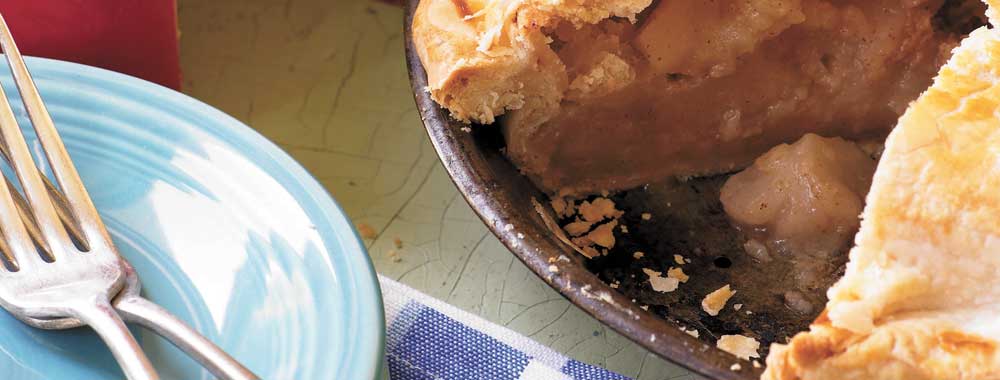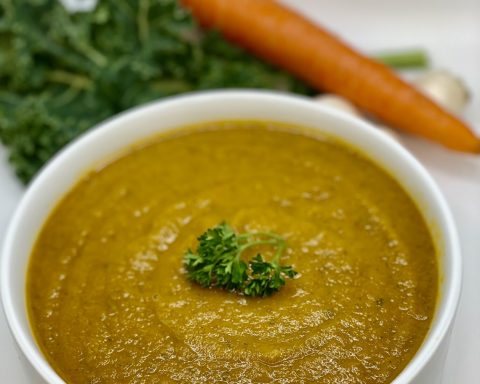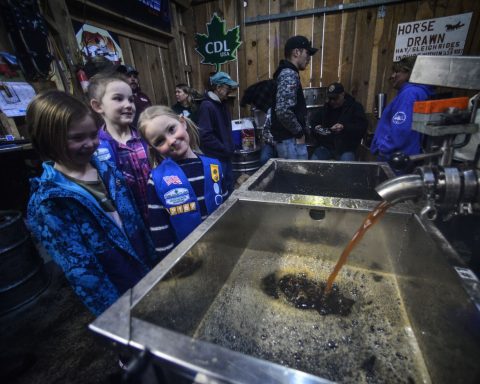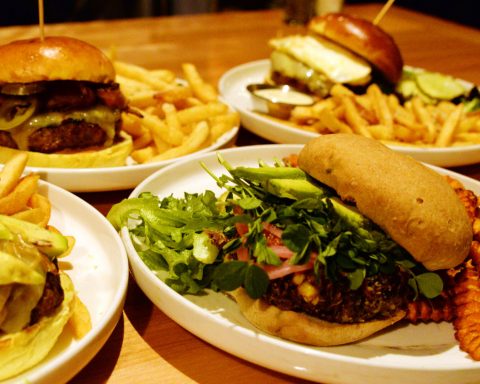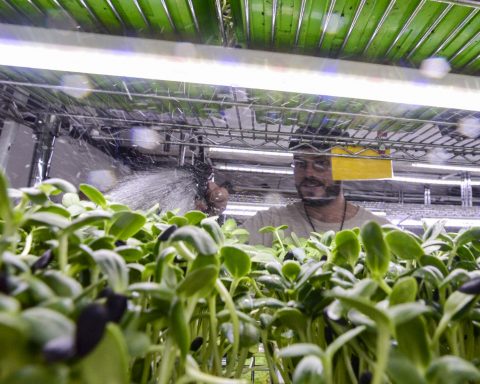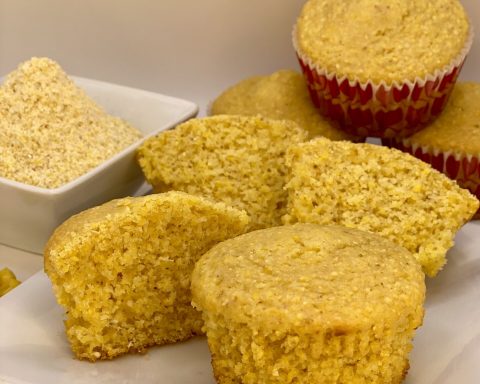Vermont Mystic Apple Pie
In this excerpt from “Dishing Up Vermont: 145 Authentic Recipes from the Green Mountain State,” author Tracey Medeiros recounts how Vermont Mystic Pie Co. owner David Barash sought out the best recipes to create the Vermont Mystic Apple Pie.
Recipe from The Vermont Mystic Pie Co., used with permission from Storey Publishing.
To find the best apple pie recipe, Dave Barash searched Vermont’s hills and valleys. He went to county fairs to seek out the blue-ribbon winners of pie-baking contests. He ate a lot of pies and reviewed a lot of recipes. He sought the advice of Vermont’s best pie makers. Assisted by The New England Culinary Institute, Dave even held a statewide contest of his own to find the best recipe. Through it all, Dave tasted many pies and learned a great deal about pie making, but he still didn’t have the recipe that he wanted: an all-natural pie with a flaky butter crust, a flavorful combination of Vermont apple varieties, and subtle seasonings.
The final decision meant going back to the drawing board to develop an original recipe. With the help of Jeff Hammelman, master baker at King Arthur Flour, the perfect crust was finally developed. After lots of experimentation, Dave settled on the best apple variety and the tastiest spice mixture. Here is the result:

DOUGH
- 1/2 cup plus 2 tablespoons pastry flour, chilled
- 1/2 cup plus 2 tablespoons all-purpose flour, chilled
- 1 stick plus 1 tablespoon unsalted butter, chilled
- 1 teaspoon kosher salt
- 1/4 cup cold water
Filling
- 1/2 cup granulated sugar
- 1/4 teaspoon ground cinnamon
- 1/8 teaspoon ground allspice
- 1/8 teaspoon ground nutmeg
- 2 tablespoons all-purpose flour
- 1/8 teaspoon kosher salt
- 4 Empire apples, peeled, cored, and cut into large slices
- 2 Cortland apples, peeled, cored, and cut into large slices
- 1 teaspoon freshly squeezed lemon juice
- egg wash
- 1 egg
- 1 tablespoon whole milk
Makes one 9-inch pie
Make the dough: Place the pastry flour, all-purpose flour, and butter in the bowl of an electric mixer. Using a paddle attachment, mix on low speed until the butter forms almond-size pieces. Mix the salt into the water. Add the salt water to the flour-butter mixture, and mix until just combined. Wrap the dough in plastic and let rest in the refrigerator for at least 30 minutes or overnight.
Divide the dough in half, one for the top and one for the bottom crust. On a lightly floured work surface, roll out each piece of dough slightly larger than 9 inches. Line a 9-inch pie plate with one of the dough rounds.
Make the filling: Mix the sugar, cinnamon, allspice, nutmeg, flour, and salt in a medium bowl until combined. Add the apples and toss to coat, then add lemon juice and stir to combine. Fill the lined pie plate with the apples. Place the second dough round on top of the apples and crimp the edges by hand. Transfer to the freezer and freeze the pie for 1 hour.
Preheat oven to 450˚F. Line a baking sheet with foil. Place the baking sheet on bottom rack of the oven to heat.
Take pie out of freezer and cut 4 air vents in the top. Whisk together egg and milk to make egg wash. Brush the top of the pie with egg wash.
Place on warm baking sheet and bake in the oven for 15 minutes. Reduce temperature to 400˚F, and bake until the top is golden brown and the juices are bubbling, another 45 to 50 minutes. Remove from oven and set aside for at least 30 minutes before cutting to allow juices to thicken. Note: If the crust begins to brown too quickly, cover it with foil.
About the book:
 When “Dishing Up Vermont: 145 Authentic Recipes from the Green Mountain State” author Tracey Medeiros moved to Vermont she immersed herself in the local food scene.
When “Dishing Up Vermont: 145 Authentic Recipes from the Green Mountain State” author Tracey Medeiros moved to Vermont she immersed herself in the local food scene.
The result?
“Dishing Up Vermont,” a cookbook filled with recipes featuring the unique tastes and rich food traditions of the Green Mountain state. You’ll learn new ways to use maple syrup, recreate that meal you enjoyed at a fancy restaurant, bake tree-ripened local apples into delicious desserts, and find out how the farmers growing the tastiest microgreens like to eat them.
Dishing Up Vermont: 145 Authentic Recipes from the Green Mountain State
Tracey Medeiros
288 pages, $19.95

Kimchi Fried Rice Balls
Excerpted from Tasting Cider, © by Sip Publishing, photography © Amy Johnson, used with permission from Storey Publishing.
Recipe by Chi’Lantro, Austin, TX
Champions of kimchi, Austin’s Chi’Lantro is “Korean barbecue inspired,” fusing Mexican and Texas influences with the pickled, the spicy, and the flavorsome. By way of nearly half a dozen brick-and-mortar shops and a food truck, Chi’Lantro brings its eclectic, multi-continental cuisine to the people of the live music capital. These kimchi-spiked fried rice balls use gochujang, a traditional Korean chili paste, which can be found at most Asian specialty markets.
Ingredients
- 1 cup kimchi, finely chopped
- 2 3/4 cups cooked sushi rice
- 1 tablespoon gochujang
- 2 cups white cheddar cheese, shredded
- 1 1/2 teaspoons toasted -sesame oil
- 1 jumbo egg, beaten
- 2/3 cup all-purpose flour
- 2/3 cup panko breadcrumbs
- 3–4 cups vegetable oil, for frying
Directions
Makes 24 balls
1. In a skillet set over medium heat, combine the kimchi, cooked rice, gochujang, cheese, and toasted sesame oil. Sauté, tossing to mix everything together, until the cheese has melted, about 7 minutes. Spread on a baking sheet to cool. Once cool enough to handle, roll into balls, using about 2 tablespoons per ball.
2. Whisk the egg in a shallow bowl. Arrange the flour and breadcrumbs in separate shallow bowls. Dip each ball into the flour, then the beaten egg, then the breadcrumbs.
3. In a deep pot over medium heat, heat the oil to 350°F (180°C). Fry the balls in small batches, turning until golden brown on all sides, about 5 minutes. Drain on paper towels and serve.
The Pairing
The Texas-born team behind Texas Keeper Cider brings the flavors of the Lone Star State to the bottle, naming the ranch-based cidery after a native apple. The Ciderweizen merges the green fruits and citrus flavors of the apples with the spicy, floral hoppiness of a German hefeweizen beer. The multifaceted cider complements the many flavors of the snack, providing crispness to the crunch of the rice ball.
Apple Cart

Excerpted from “Tasting Cider,” © by Sip Publishing, photography by © Amy Johnson, used with permission from Storey Publishing.
Recipe by Lauren Mote, Bittered Sling Bitters and UVA Wine & Cocktail Bar, Vancouver, BC
“When discussing all things apple, it’s important to me to not only use apple-related products but complementary flavors that taste incredible alongside apples,” says Lauren Mote, the proprietor of bitters and tincture producer Bittered Sling and bar manager at the ultra sleek UVA in Vancouver. For the celebrated Canadian cocktail queen, the Apple Cart is a liquid embodiment of this stance on true flavors. “It is a combination of great ingredients, topped with a funky, tart, and refreshing cider,” she says of the cocktail. “Bourbon has an inherent baked apple note, sherry’s got a bit of crisp, fresh apple on the nose . . . and spiced apple on the palate.” For Mote’s tannic syrup, dried hops can be found at a homebrew store or online.
Ingredients
- 1 1/2 ounces Bulleit bourbon
- 1/2 ounce Aperol
- 1/2 ounce Lustau East India Solera sherry
- 3/4 ounce lemon juice
- 3/4 ounce Tannic Apple Syrup
- 2 dashes Bittered Sling Zingiber crabapple bitters
- 4 ounces Tree Brewing Dukes Cider Dry Apple cider
- Bouquet of lemon verbena and mint, for garnish
The Cider
- Dukes Cider Dry Apple from Tree Brewing, Kelowna, BC
Cider made from a brewery in the center of British Columbia’s wine country, Dukes Dry Apple is produced exclusively from apples grown in Kelowna — now a hotbed for cider fruit. Dry, tart, and lightly carbonated, this cider does the trick for Mote’s multifaceted sipper.
Directions
Makes 1 cocktail
Combine the bourbon, Aperol, sherry, lemon juice, syrup, and bitters in a shaker with ice. Strain into a tall collins glass filled with fresh ice. Top with the cider, stir gently, and serve garnished with a bushy bouquet of lemon verbena and mint.
About the book:
 “Tasting Cider: The CIDERCRAFT® Guide to the Distinctive Flavors of North American Hard Cider,” is the complete guide to North America’s oldest beverage — hard cider. Author Erin James, the editor-in-chief of “CIDERCRAFT®” and “Sip Northwest” magazines, offers up flavor profiles and tasting guidelines for 100 selections of cider — including single varietal, dessert, hopped, and barrel-aged — plus perry, cider’s pear-based cousin.
“Tasting Cider: The CIDERCRAFT® Guide to the Distinctive Flavors of North American Hard Cider,” is the complete guide to North America’s oldest beverage — hard cider. Author Erin James, the editor-in-chief of “CIDERCRAFT®” and “Sip Northwest” magazines, offers up flavor profiles and tasting guidelines for 100 selections of cider — including single varietal, dessert, hopped, and barrel-aged — plus perry, cider’s pear-based cousin.
In addition, James includes 30 food recipes — from Brussel sprout salad to salmon chowder, brined quail and poached pear frangipane — and suggestions of which cider to pair with them. An additional 30 cocktail recipes include creative combinations such as Maple Basil Ciderita and Pear-fect Rye Fizz.
Tasting Cider: The CIDERCRAFT® Guide to the Distinctive Flavors of North American Hard Cider
Erin James
288 pages, $19.95
